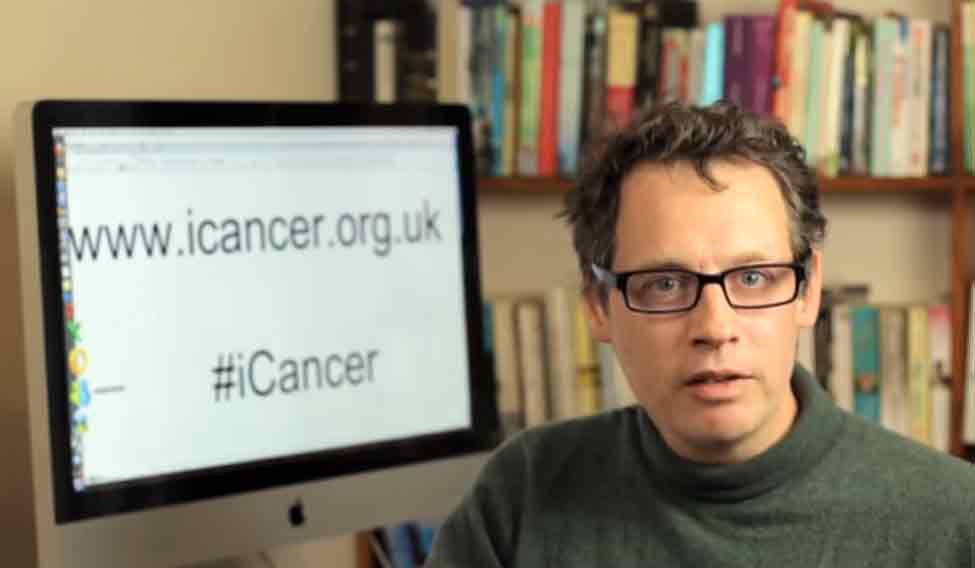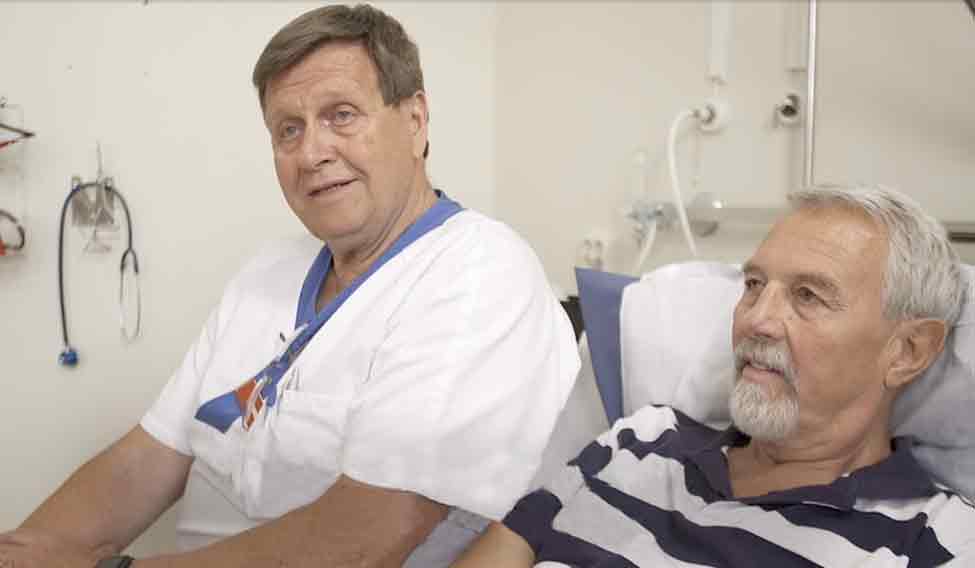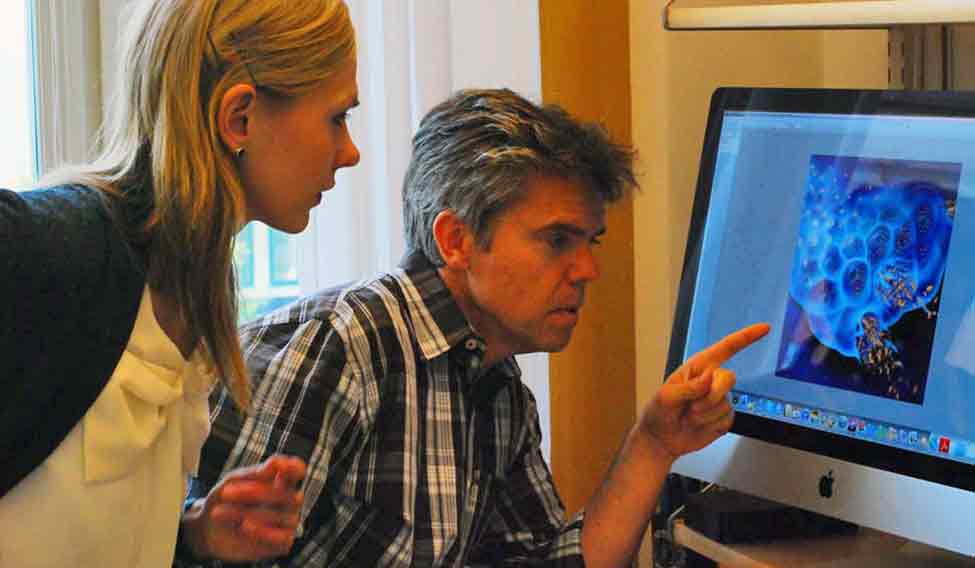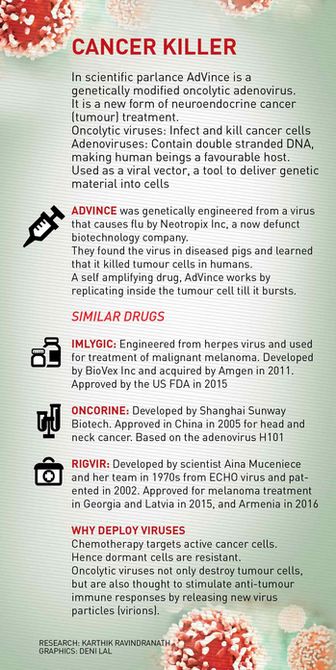The first person in the world to receive the only crowdfunded cancer drug in history will be Jan Smørlung, a village fire inspector, who doesn’t mind us pointing our camera lens at his groin.
“Yes, thank you. I am happy to assist the world,” he says.
A plump, healthy-looking man with a fresh haircut, wearing a white T-shirt, he looks like someone who rows out into misty forest lakes to catch a fish for breakfast. He has two children, six grandchildren and not much time.
For over a decade, Jan’s consultant, world famous clinician Kjell Öberg, has held back the inevitable with every treatment so far known to medicine, from chemotherapy to small radioactive balls dribbled into Jan’s blood. Neuroendocrine tumours (NETs) such as his are slow-growing, but unless completely removed by surgery they generally get you in the end. (They usually occur in the intestine, but they are also found in the pancreas, lung and other parts of the body.) A few months ago, Jan’s tumours lost patience with the shilly-shallying and began to expand unstoppably.
The new crowdfunded drug, financed by 2,000 people living in 40 countries, plus one supremely generous oilman from Geneva, is called AdVince. In a few hours, a timorous dose will be pumped into a tube between Jan’s legs, along the hepatic artery and into his tumour-infested liver.
Cancer trials proceed with agonising slowness. To the patient they can have the feel of a nightmare. These opening doses (known as Phase One of the trial) are to test the safety of the drug, and seem all but homoeopathic. They are diluted to be hundreds of times lower than the expected effective dose. It will be well into next year before Phase Two of the process begins, when Jan will get to try potentially useful quantities of the new drug.
“Shadows good, shoot straight on the bed,” mutters Dave, our cameraman, brushing past Öberg, as if the professor were no more than a tea boy. “We could pull the curtain round, let’s see how stable the light is….”
“Do you know why the drug is called AdVince?” asks Liz, who is prepping Jan for a website video to celebrate the start of the trial. Jan shakes his head contentedly. “Vince was the oilman. He paid three-quarters of the money needed for this trial, on the condition that he would also be allowed to join it. What do you think of that?”
“Did he pay for three-quarters of me, too?”
“For everyone. But his condition was that he be included, too.”
“I thank him with all my heart. He is a good man.”
 Alexander Masters stumbled upon AdVince while hunting the web, trying to find new treatments for his best friend, Dido Davies, who had neuroendocrine tumours | Courtesy: www.Icancer.org.uk
Alexander Masters stumbled upon AdVince while hunting the web, trying to find new treatments for his best friend, Dido Davies, who had neuroendocrine tumours | Courtesy: www.Icancer.org.uk
There are four-and-a-half of us fluffy-headed media types who have flown out here to Uppsala University Hospital, in Sweden, to gawp at Jan’s middle bits: Liz Scarff who, with her partner David Carter, runs a strategic creative consultancy called Fieldcraft Studios; Dominic Nutt, a communications expert (who has just contracted a cold, gone red in the face and disappeared back to our hotel); me, a biographer, and Stella (daughter of Liz), aged 11 months. None of us knows a thing about medicine.
Yet without us, Jan wouldn’t be lying here. We are the ones who discovered AdVince lying neglected in Uppsala’s research-lab freezer, formed a campaign group called iCancer and, together with the 2,001 other donors around the world whom Jan has never met and who have never heard of him, raised £2 million to get the drug defrosted and infused into the top of his thigh.
We are also here because, during the process, we think we discovered a radical new way to raise money for the vast numbers of potential medications currently neglected in laboratories around the world. It is such a simple idea that it is astonishing no one has thought of it before.
Jan is taking part in Phase One not just of AdVince, but also of what we have dubbed the Plutocratic Proposal.
AdVince is a genetically modified oncolytic adenovirus. In medical parlance, it is 'an advanced biologic'. In campaigner talk, it is a cancer-eating bug. It has been engineered from a virus that causes flu. It is mutant sniffles.
I first heard about AdVince (or Ad5[CgA-E1A-miR122]PTD, as it was then called) four years ago and 5,000 miles away from Jan’s village on the Swedish coast. I was sitting in my girlfriend’s apartment in New York, watching a YouTube video about diseased Canadian pigs. My best friend, the biographer Dido Davies, was dying of NETs that had begun in her pancreas—the same disease that killed Steve Jobs—and for 18 months I had been hunting through the web, trying to find new treatments for her. Dido’s tumours had come back. They had seeded in her blood and were crowded in her liver.
The YouTube lecture had been up for three years, had recorded a total of 48 views, and the man presenting the talk claimed his biotech company (whose name he forgot to mention) had discovered a virus in diseased pigs that killed NET cells in humans. The drug had been approved for clinical tests by the FDA (the Food and Drug Administration—America’s all-powerful and perfectionist medical approval body) and two human trials were under way.
 For over a decade, Jan Smørlung’s (right in pic) consultant, Kjell Öberg, has held back the inevitable with every treatment so far known to medicine, from chemotherapy to small radioactive balls dribbled into Jan’s blood | Courtesy: www.icancer.org.uk
For over a decade, Jan Smørlung’s (right in pic) consultant, Kjell Öberg, has held back the inevitable with every treatment so far known to medicine, from chemotherapy to small radioactive balls dribbled into Jan’s blood | Courtesy: www.icancer.org.uk
I spotted an address on a poster behind the lectern, froze the film, enlarged the picture until I could read the name Neotropix, and rang the company up. No answer. It had gone bust two years earlier. The venture capitalists backing the research hadn’t seen a quick enough return, so had abandoned everything: the company, the drug, the hospitals running the trials, even the patients whose tumours were starting to disappear. It turns out this is a common situation.
But the failure put me on the right track. A link on the company’s defunct website led me to a series of articles in internationally respected journals by Professor Magnus Essand and Dr Justyna Leja at Uppsala University. They had also developed a virus that specifically targeted neuroendocrine cancer cells, and had been forced to abandon their promising work for lack of funds. But they were still answering the phone.
“If I raise the money you need to get this drug back into clinical research, will you promise to put my friend Dido on the trial?” I asked.
It was a question that showed absolutely no understanding of accepted medical practice, was perhaps ethically abhorrent and quite possibly illegal.
“Yes,” said Professor Essand.
The first thing I did was the only thing a part-time hack like me could think of doing: write an article and send it to The Sunday Telegraph, where I had once published some travel pieces: 'A virus that kills cancer: a cure that’s waiting in the cold.' Then I waited. Monday passed, Tuesday... the article went, appropriately, viral, but my phone stayed silent. Wednesday, Thursday... Two Sundays later, I got a beautifully written response: another article in the Telegraph, by Dominic Nutt. 'Would I take an untested cancer treatment myself? Hell, yes!' He had recently had a neuroendocrine tumour removed, and said that if he had had the £2 million I needed, he would give it to me; only, he didn’t have it.
It felt as though we were characters in a Sherlock Holmes story, calling to each other through the columns of a newspaper.
The next day, I met Dom on the balcony of the Wetherspoons pub in Victoria station. He introduced me to his friends Liz and Dave, whose award-winning company specialises in social media campaigns, and over beer and lemonade we set up iCancer.
Eight months later, the money raised from crowdfunding online was on the lab bench of Professor Essand and Dr Leja.
Beyond the window of Jan’s room, there are enormous building works. Cranes hum and clank as they lift concrete hoppers high into the air, then reel them down again at speed to be disgorged into the sprawling foundations. Uppsala is extending its oncology, radiotherapy and surgery departments with a nine-floor new building costing 2 billion Skr (£165 million). The Swedish population is growing fast, and cancer is booming.
 Professor Magnus Essand and Dr Justyna Leja at Uppsala University had developed a virus that specifically targeted neuroendocrine cancer cells | courtesy: www.icancer.org.uk
Professor Magnus Essand and Dr Justyna Leja at Uppsala University had developed a virus that specifically targeted neuroendocrine cancer cells | courtesy: www.icancer.org.uk
The fact that certain viruses successfully attack cancer cells has been known since the 1890s. What has taken 130 years to figure out is a) how to make the effect last longer than a few weeks and b) how not to kill the patient in the process. When modern scientists began to investigate the field, genetically engineered examples such as AdVince were treated with the same caution as Ebola. One fear was that these modifications of a sneeze might break out of the labs and infect the fuel in aeroplane tanks: regulators actually believed it would make Boeing 747s drop out of the sky. The film I Am Legend is about an artificially modified cancer-eating measles virus that takes over the world by killing 90 per cent of the population. The film is set in 2012, the same year that our campaign group, iCancer, handed over the money to the University of Uppsala.
These days, the panic has died down. After AdVince enters Jan’s body, it will swarm down his hepatic artery, confined inside the catheter until the final second, and be released into his tumour-infested liver. The reason for the catheter is not to protect Jan from the virus, but the virus from Jan. Professor Essand and Dr Leja’s main concern is that Jan’s immune system will eliminate the drug before it has a chance to attack his tumours. However, AdVince is a self-amplifying drug: the viruses work by replicating themselves inside the tumour cell until it bursts. So there is just a chance something might happen even in the early, timid doses of a Phase One trial.
A nurse knocks on Jan’s door and strides in carrying a metal tray of implements, flustered by the squash and squeeze in the room. Before Jan can receive his innocuous dose he needs to be washed and checked 'for vital signs'.
“This is a very big chance for me,” says Jan merrily, swinging off the bed and beginning to undress.
“We are pretty sure he is alive, but it is good to check,” jokes Professor Öberg, as we leave the room.
“Essentially what Dave and I do for a living is tell stories on a huge scale,” says Liz. “And this is just such a brilliant story: here in Sweden is a potential treatment that could help save thousands of people’s lives. Why would you not donate £5, £10, £15? I never, for a minute, thought we wouldn’t raise the money for the trial.”

According to the Financial Times, the crowdfunding part of our campaign, which Liz set up and ran, is the most successful of its type in web history. Of the final amount, she and Dave raised £700,000 this way. Yet Liz has not charged iCancer a penny for her work.
I have sometimes wondered about this. Why did she choose to join iCancer? There are dozens of good stories of neglected drugs not being developed for want of a few pounds.
“Aren’t there also inheritable forms of the disease?” Liz asks Professor Öberg in the corridor, as we are waiting for Jan’s injection to begin. This is unexpected, because Liz usually insists she knows nothing about the illness, so when she adds, bafflingly, “Men to be?” it sounds as though she is talking about another sci-fi film in which all the men of the future die, this time of neuroendocrine cancer.
“Yes,” says Öberg, also surprised. “MEN-1, MEN-2a and MEN-2b are all genetic variants that can be inherited. Why?”
For a second Liz does not reply. She returns to her notepad and jots down a few marks.
“My mother has it,” she says.
Half an hour later, the tube penetrates Jan and six years of research, two years of neglect and eight months of fundraising flow into his diseased liver.
Liz sat up sharply when the light above the door into the operating room turned from green to red.
“Jan is in there because 2,000 people in 40 different countries paid for him,” she repeated. “They paid for him to have this chance. That will never cease to amaze me.” She was close to tears.
Now that Jan is dosed up and the new drug is getting the testing it needs to see if it is any good, there is no longer any reason for us to go on with our work. Dido died three years ago. Vince died eight months after making his extraordinary donation. From my point of view, the money was raised in the hopes of getting them on this trial. Neither lived long enough to claim the prize. We found AdVince and began our fundraising too late. These days what worries Dom most is his diabetes, not his cancer. But iCancer will continue. We want to show that Uppsala wasn’t a fluke: that the fundraising approach which we accidentally developed is a good way to get other neglected drugs out of their freezers and into clinical trials. Generalise our tactic in a way that does not promote quackery and you have, we believe, the chance to raise billions of pounds of new money for peer-reviewed, quality medical research.
I call it the Plutocratic Proposal, and I can sum up the idea in three words: 'sell' trial places. It was effectively what I wanted Professor Essand to do for Dido when I first rang him in 2011. It was what Vince was after, when he made his extraordinary donation. The trick is to do it sooner, quicker, not towards the end of a patient’s life, but at the point of diagnosis, at the start of a disease.
Everything honourable and judicious about the idea depends on those quotation marks around the word 'sell'. It is not a standard sale. What the plutocrat who provides this new type of funding is saying is: 'I will finance this neglected drug (that otherwise would not stand a chance of being developed) to be tested in all the poorer patients on a trial. All I ask in return, is that I be allowed to tag along.'
Every year, dozens of promising new cancer treatments are thrown out. There is nothing wrong with these drugs and interventions: they have been developed in leading laboratories by respected scientists around the world. In pre-clinical studies, they have shown remarkable potential to lessen suffering and prolong thousands of lives. Why are they discarded? Because the researchers have run out of money. How much money?
Around £2 million, or roughly just under one half of one per cent of what Sir Philip Green creamed off BHS [British Home Stores].
 I Am Legend (above, a still from the film) is about an artificially modified cancer-eating measles virus that takes over the world by killing 90 per cent of the population. It is set in 2012, the year iCancer handed over the money to the university.
I Am Legend (above, a still from the film) is about an artificially modified cancer-eating measles virus that takes over the world by killing 90 per cent of the population. It is set in 2012, the year iCancer handed over the money to the university.
The Plutocratic Proposal is venture capitalism with a socialist step. Unlike ordinary venture capitalism, the return is not money, but another shot at health, and the investors are shackled to beneficence. The plutocrat can’t skulk off with everybody’s cash to buy a third superyacht. The Plutocratic Proposal should appeal to both Jeremy Corbyn and Donald Trump.
Last year, we published a thanking 11,000-word article on the subject in the Wellcome Trust’s emagazine, Mosaic. It won the 2015 Investigative Science Journalism Award. Oxford University has asked us to write an ethical analysis of the idea for the Journal of Medical Ethics.
On our last night in Uppsala, Professor Essand got out his guitar and held a rock concert. It was not a big party. It was in the virotherapy lab canteen, and Professor Essand’s delightful, generous team of international students jiggled embarrassedly in a circle. Dave and Liz had to return to the hotel to look after Stella and sort out the plentiful footage of Jan. Dom was still sick in bed. Dr Leja couldn’t join in because she is eight months pregnant.
So I danced with Vince’s widow, Mona. We were wild, flinging out our arms and legs while Professor Essand and his band bellowed. I don’t know why we danced so vigorously. It was wonderful to celebrate the arrival of a new potential medication; it was good to think we might have an idea that could save other neglected drugs; but both the people we had fought for had died.
Go to icancer.org.uk to find out more and watch the film of Alexander Masters’ visit to Uppsala.






